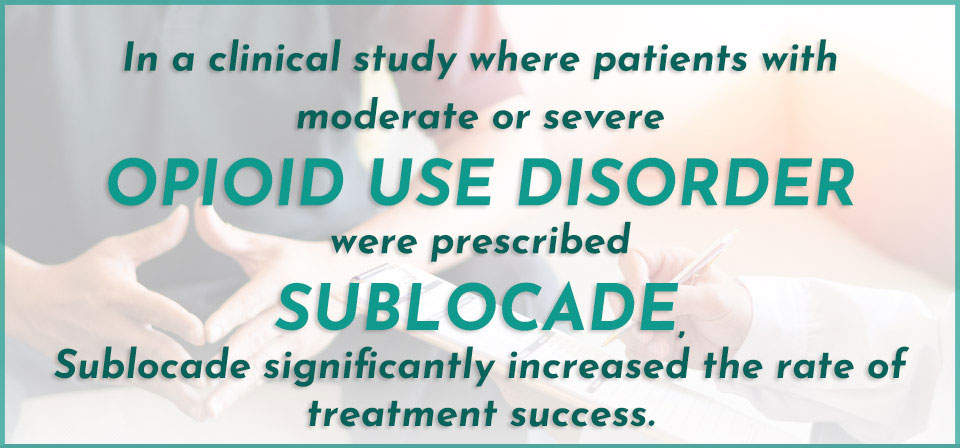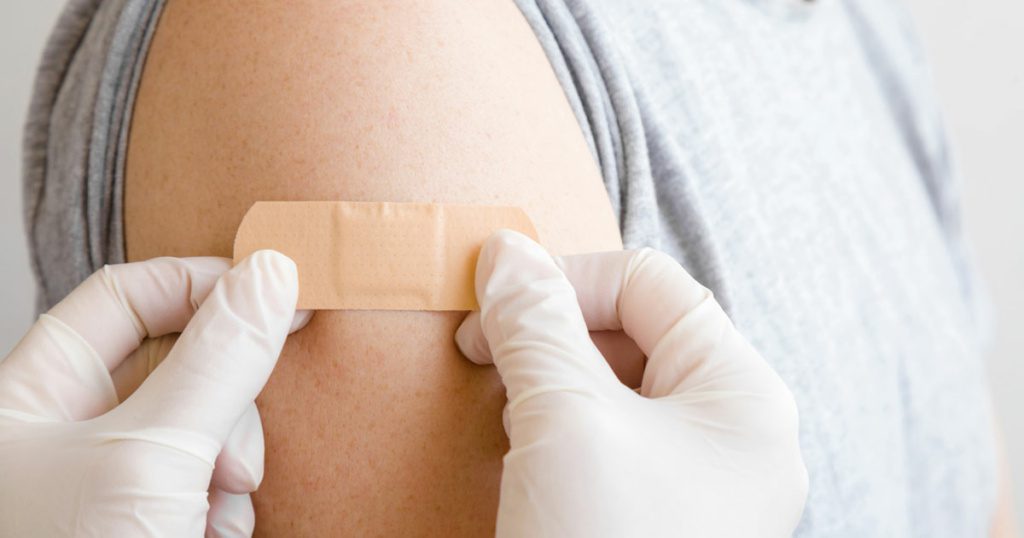Sublocade is a form of FDA-approved medication assisted treatment (MAT) for patients suffering from opioid abuse/dependence. Sublocade was approved for medical use by the FDA in 2017 as a once-a-month buprenorphine depot injection. While there are many treatments available that can help you or a loved one recover from opioid addiction, we at Illuminate Recovery advocate the use of Sublocade.
How Does Sublocade Work?

Sublocade, a buprenorphine product, works by blocking the effects of opioids. Buprenorphine, a partial opioid agonist, is one of several FDA-approved medications for opioid disorder and is intended for long-term MAT. Buprenorphine is the active ingredient in a Sublocade depot injection that blocks opioid receptors to get the clinical effect.
Patients will receive one Sublocade injection once a month, during which the Sublocade medication is released into the body through Atrigel technology. Atrigel is a delivery system that slowly deposits increments of the full dose of buprenorphine into subcutaneous fat tissues over one month. Sublocade provides sustained therapeutic plasma levels of buprenorphine for one month. Because of this, patients who receive Sublocade do not need to take sublingual medication.
Adult patients must first start a stable dose of buprenorphine treatment for at least seven days before they can begin to receive Sublocade monthly injections for the treatment of moderate-to-severe opioid use disorder. Initiating treatment with a sublingual buprenorphine-containing product for seven days will allow the body to stabilize and adjust to dosage during the transition to Sublocade. Sublocade should be used as part of a complete MAT program that includes a prior sublingual buprenorphine product, counseling, and psychological support.
Sublocade is administered monthly, by a healthcare provider, via a subcutaneous injection in the abdominal region. The recommended dose of Sublocade starts with two monthly doses of 300 mg, followed by once-a-month 100 mg doses. Many of our patients worry about the safety of various forms of long-term MAT to treat opioid addiction and what could happen if they accidentally take more than prescribed. This is what makes Sublocade safe and effective—Sublocade’s ultra-low dose design and opioid suppressing nature greatly decreases the chance of overdose.
Common side effects of Sublocade include:
- Constipation: We recommend finding preventative measures, such as fiber supplements and drinking plenty of water, to counteract the side effects.
- Nausea: When Sublocade attaches itself to opioid receptors in the brain, it can trigger nausea symptoms. This side effect may last until the body becomes used to Sublocade medication.
- Vomiting: We recommend finding preventative measures, such as eating ginger, to alleviate both vomiting and nausea symptoms. It is important that Sublocade patients frequently consult with their doctors to make sure treatment is going smoothly and not interfering too much with normal daily life.
Inform your doctor beforehand if you take the following medications:
- Antibiotics
- Medications for blood pressure or heart condition
- Antifungal medication
- Seizure medication
- Hepatitis C or HIV medication
- Cold and allergy medication, including bronchodilators
- Other narcotic medication
- IBS or motion sickness medication
- Valium and other sedatives
- Medications that result in drowsiness
- Medications that affect serotonin levels
Here are the key takeaways from how Sublocade works:
As a partial agonist, Sublocade acts as a blocker. Sublocade blocks opioids from attaching to mu opioid receptors by binding itself and activating those same receptors.
By blocking these receptors, Sublocade tricks the brain into thinking that a full agonist—like oxycodone or heroin—has been used. By doing this, it blocks the pleasurable side effects that result from those opioids binding to receptors.
Sublocade is a narcotic. Narcotics, another term for opioids, are a wide variety of controlled drugs produced from a base of opium. Opioid medications such as Sublocade (and therefore buprenorphine) are also narcotics and can be used to treat people with moderate to severe opioid addiction.
One Sublocade injection lasts one month. That means a single injection will last 28-30 days. Occasional delays (of up to two weeks) in dosing are unlikely to have a significant impact in treatment. For instance, if a patient receives an injection two weeks late, it is unlikely they will experience a return of withdrawal symptoms or cravings.
What’s the Difference Between Sublocade and Suboxone?

Methadone is full agonist therapy for long-term assistance with opiate abuse. By replacing the addiction opioid with the methadone opioid, it reduces withdrawal symptoms and helps patients slowly wean off the addiction opioid.
Buprenorphine—such as Sublocade and Suboxone—is a sublingual agonist antagonist indicated for long-term MAT. It is a synthetic opioid that partially stimulates opioid receptors. Therefore, patients will not feel the same brain effects of addiction from addiction opioids, while also not going through intense withdrawal.
Naltrexone is an opioid antagonist that comes in the form of a shot or implant that lasts for one to two months. Naltrexone is not an actual opioid, nor does it cause withdrawal symptoms, but it is only intended for short-term use and relapse prevention.
Many people ask us, “is Suboxone the same as Sublocade?”
While both MAT use buprenorphine, Suboxone and Sublocade have the following major differences:
- Sublocade is an injection, while Suboxone is a film that is put under the tongue.
- While Sublocade is a once-monthly injection, Suboxone is taken daily.
- Sublocade only contains buprenorphine. Suboxone contains buprenorphine and naloxone—which helps protect patients from accidental overdose.
- While Sublocade must be injected subcutaneously by a doctor, Suboxone can be administered by a healthcare professional or at home.
- Sublocade can only be given to those who had been on Suboxone or another form of buprenorphine treatment for at least seven days.
What’s the Distinction Between Sublocade and Suboxone?
Buprenorphine’s status as a partial agonist makes it less dangerous and less likely to be abused. Sublocade is not used to treat pain, and instead works by preventing cravings. Buprenorphine produces the same effects that other opioids do—to include pain relief, respiratory depression, euphoria, and brain opioid receptor occupation. However, buprenorphine produces these effects in far weaker amounts compared to other opioids. By weakly mimicking opioids like morphine or heroin, it also inhibits the effects of other opioids.
What Is the Success Rate of Sublocade?
In a clinical study where patients with moderate or severe opioid use disorder were prescribed Sublocade, Sublocade significantly increased the rate of treatment success. Patients demonstrated ≥80% in illicit opioid-free weeks compared to patients treated with a placebo. Patients treated with once-monthly Sublocade injections and counseling were 14 times more likely to have treatment success compared to the placebo.

Sublocade and MAT
Professionals suggest MAT — a combination of carefully prescribed medications alongside counseling and behavioral therapy—to slowly and safely ease brain chemistry back to normal and to provide opioid addiction treatment with long-lasting results. Quitting opioids cold turkey can be very dangerous and could cause severe symptoms: including painful withdrawal and an increased chance of relapse.
Sources:
- https://www.aamc.org/news-insights/21-million-americans-suffer-addiction-just-3000-physicians-are-specially-trained-treat-them
- https://www.sublocadehcp.com/clinical-study-phase-3
- https://www.healthline.com/health/drugs/sublocade-vs-suboxone#uses
- https://www.drugs.com/medical-answers/difference-between-sublocade-suboxone-3535227/
- https://www.fda.gov/news-events/press-announcements/fda-approves-first-once-monthly-buprenorphine-injection-medication-assisted-treatment-option-opioid




